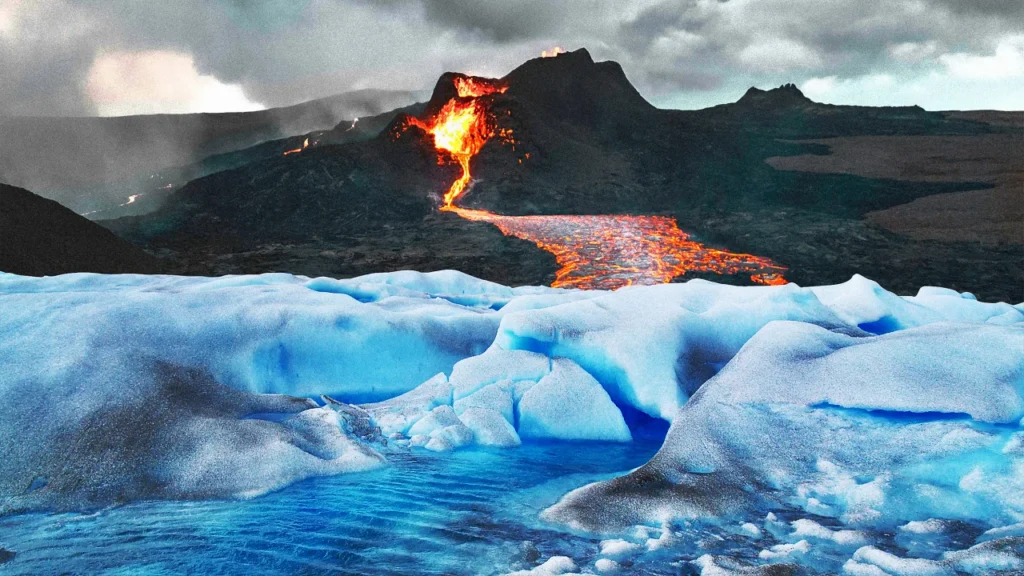
As global temperatures increase because of climate change, glaciers around the world are melting—contributing to rising sea levels, more extreme weather events, and habitat loss for all sorts of species. But scientists have recently identified another explosive consequence from this disappearing ice: Melting glaciers may lead to more frequent, and more damaging, volcanic eruptions.
Those volcanic eruptions could then cause even more climate impacts by spewing greenhouse gases into the atmosphere, which will then melt more glaciers. Though individual volcanic eruptions may temporarily cool global temperatures (by releasing aerosols that reflect the sun away from the Earth’s surface), multiple, consecutive volcanic eruptions can actually contribute to global warming.
“This creates a positive feedback loop, where melting glaciers trigger eruptions, and the eruptions in turn could contribute to further warming and melting,” Pablo Moreno-Yaeger, a University of Wisconsin-Madison researcher, said in a statement. Moreno-Yaeger presented his team’s findings at the geochemistry Goldschmidt Conference in Prague this week; a peer-reviewed paper on the research is forthcoming.
Melting glaciers increase volcanic activity because of the way they sit over stores of magma underground. When ice sheets melt and glaciers retreat, it releases the pressure on those magma chambers, making it easier for the magma to break through the surface in a volcanic eruption. That process has already been observed in Iceland, but the new study looking at volcanoes in Chile is one of the first to show how the phenomenon played out at the end of the last ice age.
The last ice age peaked around 26,000 to 18,000 years ago, and the thick layer of ice over the planet then suppressed volcanic eruptions. That led a reservoir of magma to build up below the surface. When the ice sheets melted, the loss of all that heavy ice released the pressure over the magma, making the gases in the magma expand so that they erupted from the Earth’s surface—like popping the top of a soda can.
For the study, the researchers, with funding from the National Science Foundation, looked at rocks around six volcanoes in the Chilean Andes. They were able to date previous volcanic eruptions and analyze the chemistry of these rocks to track how volcanic explosions increased as glacial ice melted.
“The key requirement for increased explosivity is initially having a very thick glacial coverage over a magma chamber, and the trigger point is when these glaciers start to retreat, releasing pressure,” Moreno-Yaeger explains. This activity is currently happening in places like Antarctica, where more than 100 volcanoes sit below the West Antarctic Ice Sheet.
The entire Antarctic Ice Sheet covers an area larger than the U.S. and Mexico combined. Climate change, fueled by the burning of fossil fuels, is already causing Antarctic ice to melt more quickly than it can be replaced—and at a rate six times faster than it was melting in the 1990s. The West Antarctic Ice sheet specifically is the “frontier of dramatic ice loss in Antarctica,” and one of the most rapidly changing ice sheets on the planet, according to the Antarctic and Southern Ocean Coalition.
It’s not just Antarctica that could see more volcanic eruptions because of melting ice. The researchers say scientists should monitor parts of North America, New Zealand, and Russia for this risk as well. The impact isn’t immediate, though; in the Chilean Andes, the volcanic eruptions lagged a few thousand years behind the melting glaciers.
But the researchers warn that different volcanoes, made up of different minerals, could respond to this change over a different amount of time. And it’s not the only climate impact that could be increasing volcanic activity. Previous research has found that more extreme, heavy rain—which is also increasing because of climate change—could trigger eruptions. And once those eruptions increase, they create a feedback loop that causes even more warming and rain.






